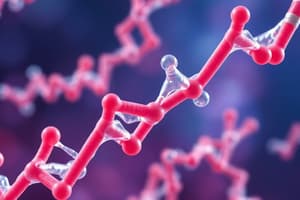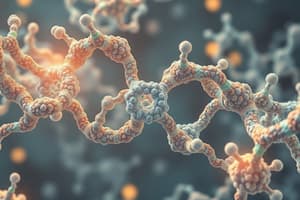Podcast
Questions and Answers
What is the name of the sweetner that is about 200 times sweeter than common table sugar (sucrose)?
What is the name of the sweetner that is about 200 times sweeter than common table sugar (sucrose)?
Aspartame
What are the two main secondary protein structures?
What are the two main secondary protein structures?
Alpha helix and beta pleated sheet
Define a primary structure, in terms of protein.
Define a primary structure, in terms of protein.
The primary structure of a protein consists of a sequence of amino acids linked together by peptide bonds and includes any disulfide bonds.
What are the 4 factors that are responsible for tertiary structures of proteins?
What are the 4 factors that are responsible for tertiary structures of proteins?
What is the protein that is a good example of a protein with Quaternary structure?
What is the protein that is a good example of a protein with Quaternary structure?
What is the term used for the unfolding of the protein molecule?
What is the term used for the unfolding of the protein molecule?
Higher temperatures promote denaturation.
Higher temperatures promote denaturation.
What are the properties of amino acids that make them good emulsifiers?
What are the properties of amino acids that make them good emulsifiers?
What are the 4 factors that affect protein-based emulsions?
What are the 4 factors that affect protein-based emulsions?
What is the process called when the protein is broken down into its individual constituent amino acids?
What is the process called when the protein is broken down into its individual constituent amino acids?
Flashcards
Tertiary structure
Tertiary structure
The overall three-dimensional arrangement of all atoms in a protein.
Primary structure
Primary structure
The specific sequence of amino acids in a protein.
Secondary structure
Secondary structure
The local folding patterns of the polypeptide chain like alpha-helix and beta-sheet.
Denaturation
Denaturation
Signup and view all the flashcards
Alpha-helix
Alpha-helix
Signup and view all the flashcards
Beta-sheet
Beta-sheet
Signup and view all the flashcards
Disulfide bond
Disulfide bond
Signup and view all the flashcards
Hydrogen bond
Hydrogen bond
Signup and view all the flashcards
Electrostatic interactions
Electrostatic interactions
Signup and view all the flashcards
Hydrophobic interactions
Hydrophobic interactions
Signup and view all the flashcards
Ion exchange chromatography
Ion exchange chromatography
Signup and view all the flashcards
High-Performance Liquid Chromatography (HPLC)
High-Performance Liquid Chromatography (HPLC)
Signup and view all the flashcards
Edman Degradation
Edman Degradation
Signup and view all the flashcards
TLCMS
TLCMS
Signup and view all the flashcards
Chaperone protein
Chaperone protein
Signup and view all the flashcards
Protease
Protease
Signup and view all the flashcards
Glycation
Glycation
Signup and view all the flashcards
Hydration
Hydration
Signup and view all the flashcards
Gelation
Gelation
Signup and view all the flashcards
Emulsification
Emulsification
Signup and view all the flashcards
Foaming
Foaming
Signup and view all the flashcards
Gelation
Gelation
Signup and view all the flashcards
Chaperone protein
Chaperone protein
Signup and view all the flashcards
Solubility
Solubility
Signup and view all the flashcards
Protein content
Protein content
Signup and view all the flashcards
Glycation
Glycation
Signup and view all the flashcards
Chaperone protein
Chaperone protein
Signup and view all the flashcards
Protein hydrolysis
Protein hydrolysis
Signup and view all the flashcards
Hydration
Hydration
Signup and view all the flashcards
Gluten
Gluten
Signup and view all the flashcards
Dispersed system
Dispersed system
Signup and view all the flashcards
Solubility
Solubility
Signup and view all the flashcards
Hydration
Hydration
Signup and view all the flashcards
Chaperone protein
Chaperone protein
Signup and view all the flashcards
Study Notes
Proteins & Enzymes
- Proteins are the workhorses of biological systems.
- They play a crucial role in building and maintaining living cells.
- Proteins are polymers of amino acids.
- Amino acids are the basic building blocks.
- Peptides are short polymers of amino acids (up to 40).
- Proteins have four levels of structure: primary, secondary, tertiary, and quaternary.
- Primary structure is the sequence of amino acids in a polypeptide chain.
- Secondary structure includes alpha-helices and beta-pleated sheets, formed by hydrogen bonds.
- Tertiary structure is the three-dimensional arrangement of the polypeptide chain.
- Quaternary structure describes the arrangement of multiple polypeptide chains.
- Proteins perform various roles, including enzymes, hormones, storage, transport, structural, protective, contractile, and toxic proteins.
- Enzymes are biological catalysts, speeding up reactions.
- They decrease the activation energy needed for reactions.
- Enzymes are highly specific to the type of reaction they catalyze and the substrates they act on.
- The active site is the region on the enzyme where the substrate binds and reaction occurs.
Amino Acids
- Around 500 amino acids are known.
- Only 20 are used to form proteins in eukaryotes (22 in total)
- Selenocysteine and pyrrolysine are incorporated into proteins via special mechanisms.
- 11 amino acids can be produced in the body, the other 9 are essential amino acids.
- Amino acids have an amino group, a carboxyl group, a hydrogen atom, and a variable side chain.
- Amino acids can be classified based on their side chain properties: polar, nonpolar, acidic, or basic.
Protein Structure and Function
- Proteins are polymers of 2-amino-carboxylic acids.
- The α-carbon atom in amino acids is a chiral center.
- All amino acids in biological systems are L-enantiomers.
- Amino acids have an amino end (N-terminus) and a carboxyl end (C-terminus).
- The primary structure is determined by the sequence of amino acids linked by peptide bonds.
- The sequence dictates the protein’s properties and function.
- Alterations in the amino acid sequence can lead to a loss of protein function.
Protein Sequence Determination
- Determining the amino acid sequence is done via Edman degradation (often on smaller proteins).
- Automated machines exist for this; often starting by determining N-terminal amino acid.
- Mass spectrometry can also be used to determine protein sequence.
Protein Classification
- Classifying proteins based on structure, roles, and other properties.
- Globular (spherical) versus fibrous (linear) proteins based on shape.
- Solubility is a key factor, depending on amino acid makeup and secondary/tertiary structure.
Protein Denaturation
- Denaturation is the loss of a protein's native, functional three-dimensional structure.
- This happens due to various factors like temperature (heat), solvents, pH, and chemicals.
- These factors disrupt the bonds and interactions holding the protein in its native conformation.
- Denatured proteins often become insoluble and lose their biological activity.
Functional Properties of Proteins
- Proteins influence structure, taste, texture, aroma, and viscosity in foods.
- The ability to bind water is crucial for various food processes.
- Proteins affect dough formation, and various other food properties.
- Several aspects influence functional protein properties like shape/structure, hydrophobicity, type of amino acid, flexibility, etc.
Protein Interactions and Phenomena Affected in Food Systems
- Proteins interaction with components such as water, ions and other macromolecules.
- The capacity to bind water
- These interactions affect various food properties, including wettability, swelling, water sorption, water retention, viscosity, emulsion formation, foaming, and gelation.
Enzyme Activity and Classification
- Enzymes are biological catalysts.
- They speed up reactions by lowering the activation energy.
- Enzymes are highly specific for their substrates and the reactions they catalyze.
- Different classifications of enzymes exist, based on the reaction type.
Enzyme Deactivation
- High temperature processing can be used to deactivate enzymes to prevent unwanted reactions during food processing.
Studying That Suits You
Use AI to generate personalized quizzes and flashcards to suit your learning preferences.





